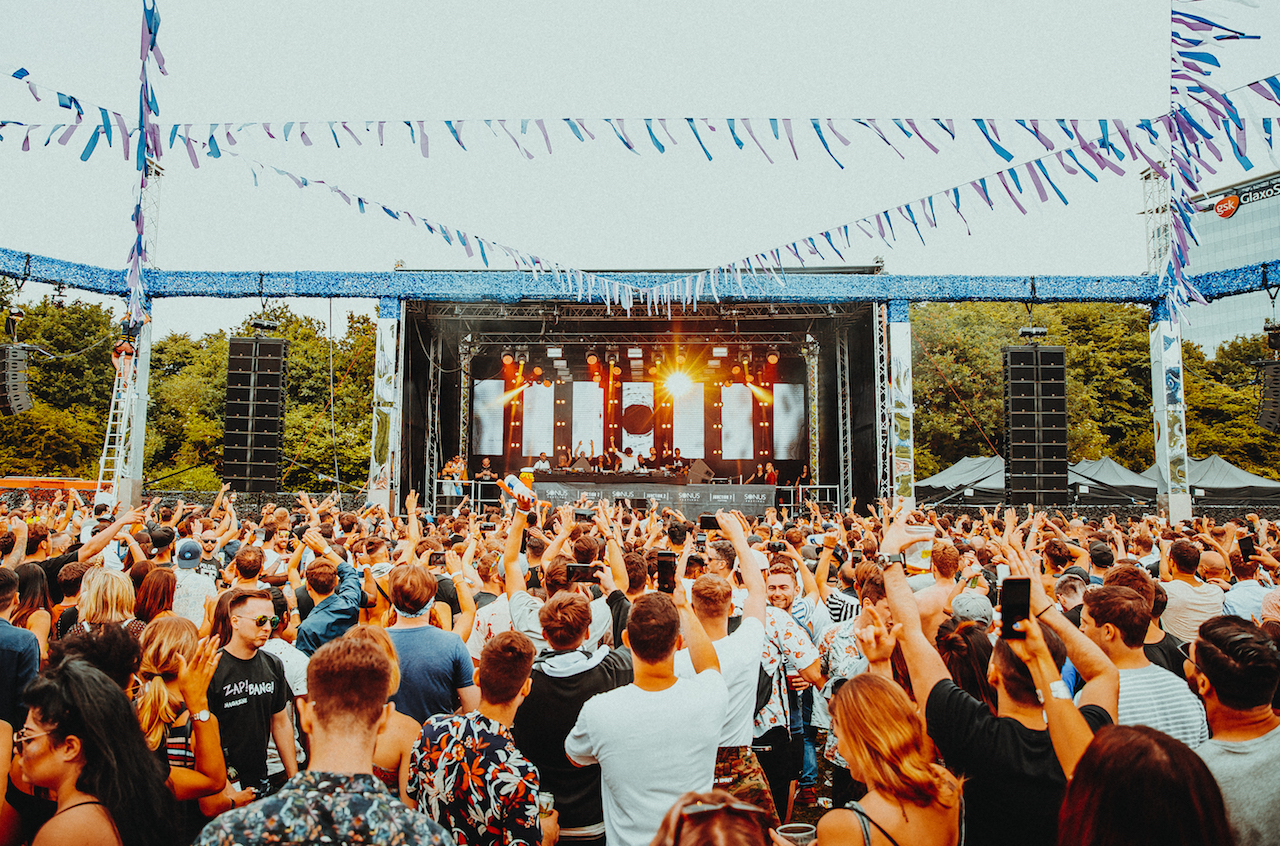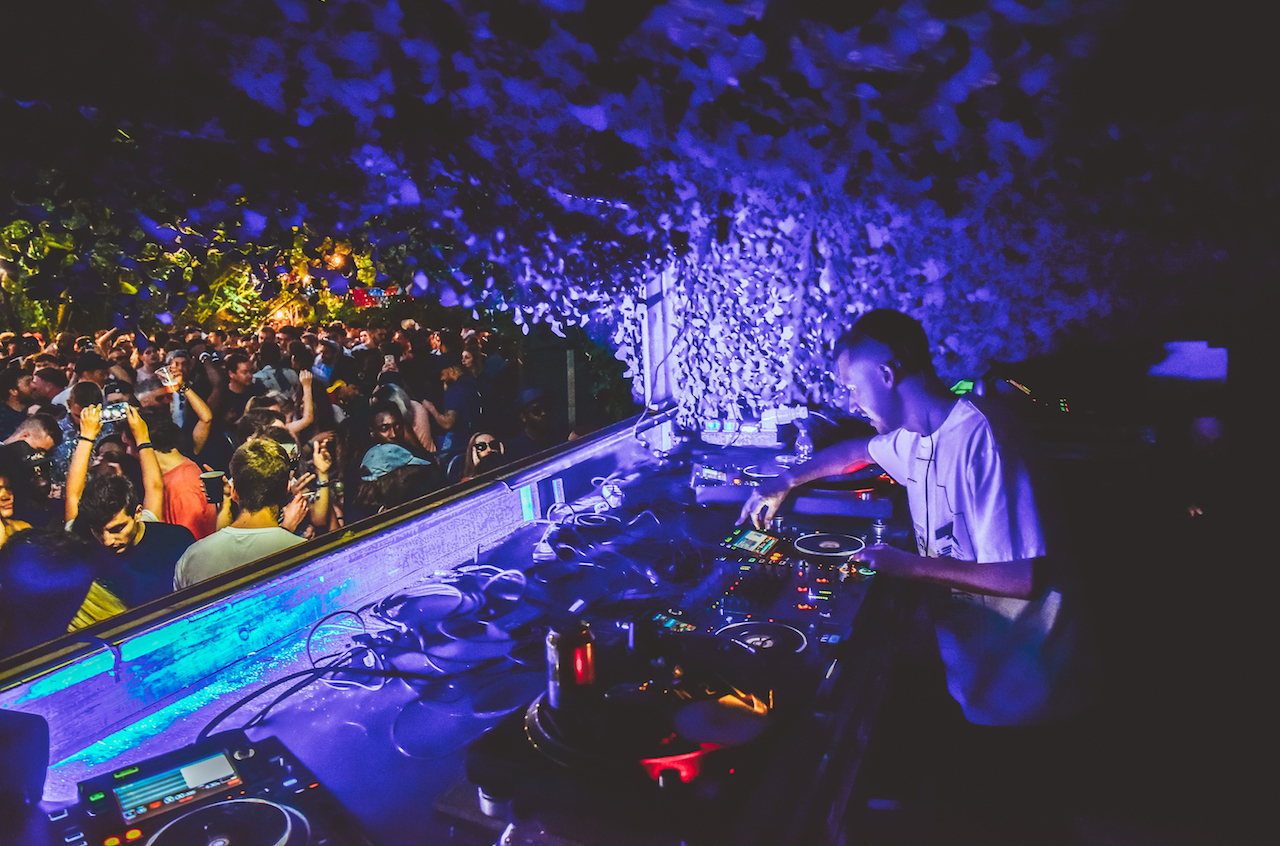- On Saturday, the third edition of Junction 2 Festival took place at Boston Manor Park, a site that manages to be both a woodland and an industrial wasteland. The M4 motorway, in all its brutalist glory, cuts through the former aristocratic estate in West London, reflecting the unstoppable advance of the metropolis. The festival's incredible main stage, The Bridge, sat under the concrete roof of the M4, looking something like a warehouse without walls out in the country.
It was immediately and refreshingly clear that Junction 2 wasn't following the direction that much of London's dance music scene has been going in—one of extreme corporate sponsorship and increasingly heavy and invasive security. Rather, it seemed as if the organisers, LWE, had been listening to people's complaints. Ravers don't want to be faced with sniffer dogs and undercover police. Plus, for the most part, Junction 2 was free of the big-money gimmicks that seem to accompany most mainstream music festivals: no rides, no ice-cream vans and no photo opportunities, with the exception of a glitter body painting stall.
Instead, the festival's website boasted "great sound, high-end production, an obsessive attention to detail, no short sets, no VIP, no plastic tents, like-minded people and a solid electronic music policy." The organisers made true on most of these claims, though the open-air setting meant a reduction in sound quality on certain stages. The Hexagon stage in particular felt more like a rock arena, bellowing sound out into the vast expanse of a disused field. Perfect for sing-along choruses, but not for the intricate details of hyper-engineered techno. This made dancing to Nina Kraviz and Maya Jane Coles a difficult experience.
By contrast, the Warehouse stage was great for immersing yourself in darker beats. The stage was something like a Berghain replica, with a temporary facade made to appear like a disused factory, complete with a fake "London Warehousing & Co" sign. The atmosphere inside couldn't be faulted, though it could have been a little louder. In here, I caught the techno trio LSD, AKA Luke Slater, Steve Bicknell and Function, serving up trippy acid abstractions like ROD's "Anindica," before Len Faki's set of reach-for-the-lasers euphoria peaked with Barrow Boy's "Genesis."
Overall, the gender balance of the crowd was close to equal, which was great to see. But this wasn't reflected in the lineup, which, despite featuring a handful of the usual big female names, still felt lacking. That said, Sonja Moonear arguably played the strongest set of the day, treating the audience to a flurry of crowd-pleasing bombs in the beautiful seclusion of the forest area, AKA The Woods. After a while, though, overcrowding detracted from the stage's charisma. By the time Joy Orbison approached the decks, the dance floor was so full I had to leave.
Junction 2 closed with a five-hour masterclass from Carl Cox and Adam Beyer at The Bridge. They delivered a thrilling performance, a dizzying barrage of peak-and-troughs, of tension and relief. I saw bodies dancing amidst the trees and around the concrete pillars of the M4. It marked a fitting end to a festival that, for me, brought together two strands of techno culture: Kraftwerk's obsession with the Autobahn and the UK's '90s rave scene.
Photo credit /
Sam Neil - Lead, Outdoor
ShotAway - Joy Orbison
 By contrast, the Warehouse stage was great for immersing yourself in darker beats. The stage was something like a Berghain replica, with a temporary facade made to appear like a disused factory, complete with a fake "London Warehousing & Co" sign. The atmosphere inside couldn't be faulted, though it could have been a little louder. In here, I caught the techno trio LSD, AKA Luke Slater, Steve Bicknell and Function, serving up trippy acid abstractions like ROD's "Anindica," before Len Faki's set of reach-for-the-lasers euphoria peaked with Barrow Boy's "Genesis." Overall, the gender balance of the crowd was close to equal, which was great to see. But this wasn't reflected in the lineup, which, despite featuring a handful of the usual big female names, still felt lacking. That said, Sonja Moonear arguably played the strongest set of the day, treating the audience to a flurry of crowd-pleasing bombs in the beautiful seclusion of the forest area, AKA The Woods. After a while, though, overcrowding detracted from the stage's charisma. By the time Joy Orbison approached the decks, the dance floor was so full I had to leave. Junction 2 closed with a five-hour masterclass from Carl Cox and Adam Beyer at The Bridge. They delivered a thrilling performance, a dizzying barrage of peak-and-troughs, of tension and relief. I saw bodies dancing amidst the trees and around the concrete pillars of the M4. It marked a fitting end to a festival that, for me, brought together two strands of techno culture: Kraftwerk's obsession with the Autobahn and the UK's '90s rave scene. Photo credit / Sam Neil - Lead, Outdoor ShotAway - Joy Orbison
By contrast, the Warehouse stage was great for immersing yourself in darker beats. The stage was something like a Berghain replica, with a temporary facade made to appear like a disused factory, complete with a fake "London Warehousing & Co" sign. The atmosphere inside couldn't be faulted, though it could have been a little louder. In here, I caught the techno trio LSD, AKA Luke Slater, Steve Bicknell and Function, serving up trippy acid abstractions like ROD's "Anindica," before Len Faki's set of reach-for-the-lasers euphoria peaked with Barrow Boy's "Genesis." Overall, the gender balance of the crowd was close to equal, which was great to see. But this wasn't reflected in the lineup, which, despite featuring a handful of the usual big female names, still felt lacking. That said, Sonja Moonear arguably played the strongest set of the day, treating the audience to a flurry of crowd-pleasing bombs in the beautiful seclusion of the forest area, AKA The Woods. After a while, though, overcrowding detracted from the stage's charisma. By the time Joy Orbison approached the decks, the dance floor was so full I had to leave. Junction 2 closed with a five-hour masterclass from Carl Cox and Adam Beyer at The Bridge. They delivered a thrilling performance, a dizzying barrage of peak-and-troughs, of tension and relief. I saw bodies dancing amidst the trees and around the concrete pillars of the M4. It marked a fitting end to a festival that, for me, brought together two strands of techno culture: Kraftwerk's obsession with the Autobahn and the UK's '90s rave scene. Photo credit / Sam Neil - Lead, Outdoor ShotAway - Joy Orbison